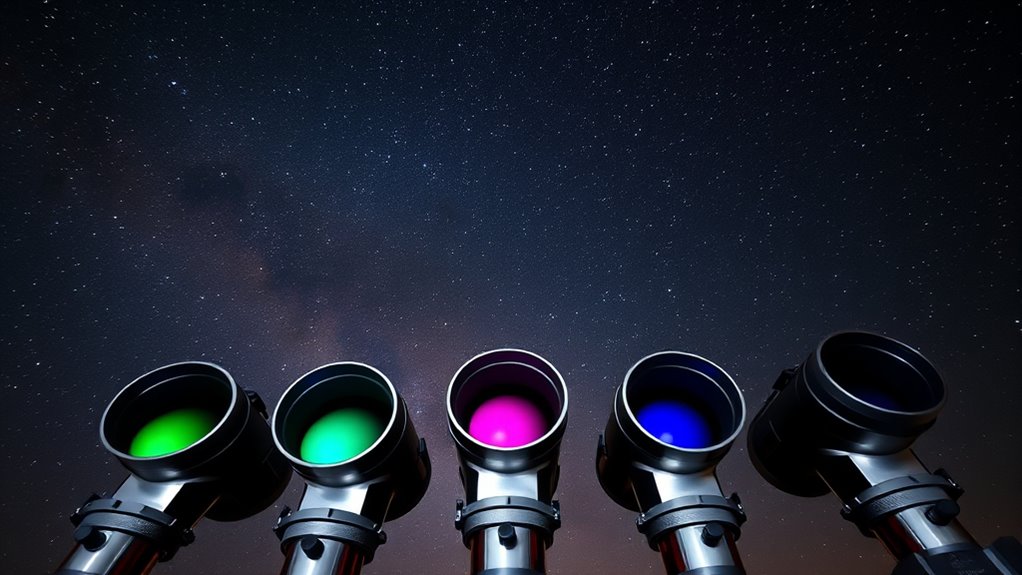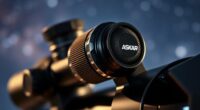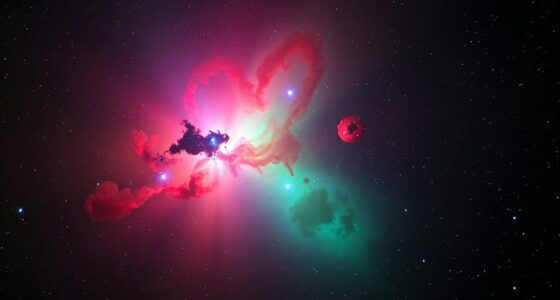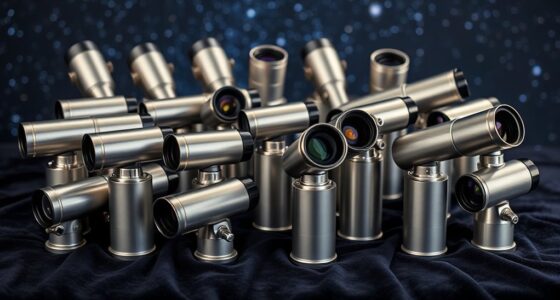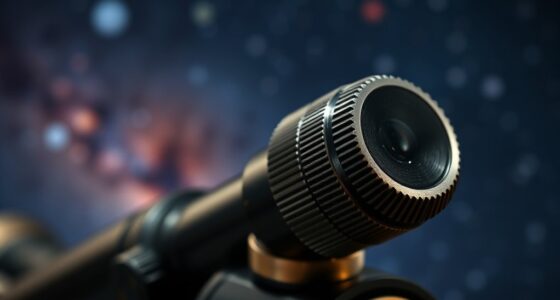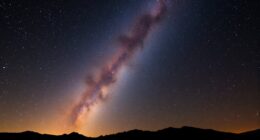If you’re after stunning views of nebulae, I recommend exploring top-tier apochromatic refractors like the Explore Scientific ED80 and ED102, Sky-Watcher EvoStar 100 APO, Omegon Pro APO, and the SVBONY SV550 bundle—all built with high-quality ED glass and coatings for sharp, high-contrast images. These models are portable, versatile, and ideal for both visual and astrophotography use. If you’re curious about which fits your needs best, stay with me—more details await.
Key Takeaways
- High-quality optical glass like FCD1 HOYA ED or synthetic fluorite ensures sharp, color-accurate nebulae images.
- Multi-layer coatings and ED-APO double-lenses minimize chromatic aberration for clearer deep-sky views.
- Apertures of 80mm to 102mm provide optimal light-gathering for faint nebulae without sacrificing portability.
- Compact, lightweight designs enable easy transport and quick setup for spontaneous nebula observation sessions.
- Compatibility with guiding systems and camera adapters enhances astrophotography potential for stunning nebula images.
Explore Scientific ED80 Triplet Refractor Telescope
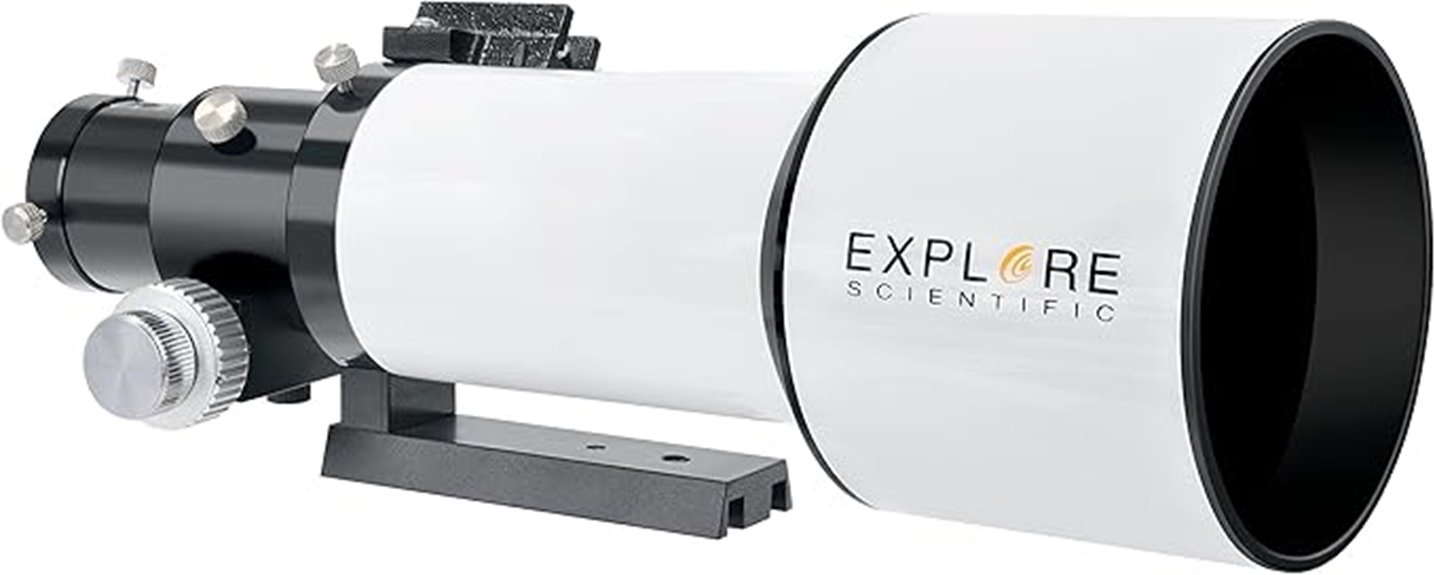
If you’re serious about capturing stunning nebulae and deep-sky objects, the Explore Scientific ED80 Triplet Refractor Telescope is an excellent choice because of its high-contrast, sharp images. It uses genuine FCD1 HOYA ED glass and multi-layer coatings to virtually eliminate chromatic aberrations, delivering superb visual and astrophotography results. Its compact design, weighing just under 6 pounds, makes it portable and easy to set up for spontaneous stargazing. The scope’s versatile f/6 focal ratio and precise collimation ensure crisp images of lunar features, planets, and faint nebulae. Whether used visually or for astrophotography, the ED80 offers impressive optical performance in a lightweight, travel-friendly package.
Best For: amateur astronomers and astrophotographers seeking a portable, high-quality apochromatic refractor for both visual observation and deep-sky imaging.
Pros:
- High-contrast, sharp images with excellent detail thanks to genuine FCD1 HOYA ED glass and multi-layer coatings
- Compact, lightweight design (~6 pounds) for portability and easy setup in various locations
- Versatile f/6 focal ratio and precise collimation allow for crisp lunar, planetary, and deep-sky imaging
Cons:
- Mounting system may require modifications or additional accessories for stable attachment
- Some users report minor manufacturing defects and occasional slipping of the mount screw
- Proprietary finder scope mount may necessitate extra rings or adapters for certain accessories
Explore Scientific ED102 Triplet Refractor Telescope

The Explore Scientific ED102 Triplet Refractor Telescope stands out as an excellent choice for astrophotographers and visual observers seeking high-contrast, detailed images of nebulae. Its 102mm aperture and f/7 focal ratio, combined with genuine FCD1 HOYA ED glass and multi-layer coatings, effectively eliminate chromatic aberrations. This results in crisp, edge-to-edge star images, vibrant nebulae, and crisp galaxy views. Designed for astrophotography, it offers precise focal length adjustments with accessories like a flattener. Its lightweight, portable build and user-friendly features make setup easy. Overall, the ED102 delivers exceptional value, especially when paired with suitable mounts, making it a top option for stunning nebulae views.
Best For: amateur astronomers and astrophotographers seeking a portable, high-quality refractor for detailed celestial imaging and visual observation.
Pros:
- High-contrast, sharp images with minimal chromatic aberration thanks to FCD1 HOYA ED glass and multi-layer coatings
- Lightweight and portable design ideal for travel and quick setup
- Versatile for both astrophotography and visual astronomy, compatible with various mounts
Cons:
- Requires additional accessories like finders, eyepieces, and adapters for full functionality
- Slightly out-of-shape stars due to mounting screw adjustments or collimation issues
- Focuser may need upgrades over time due to initial backlash and tension limitations
Sky-Watcher EvoStar 100 APO Refractor Telescope
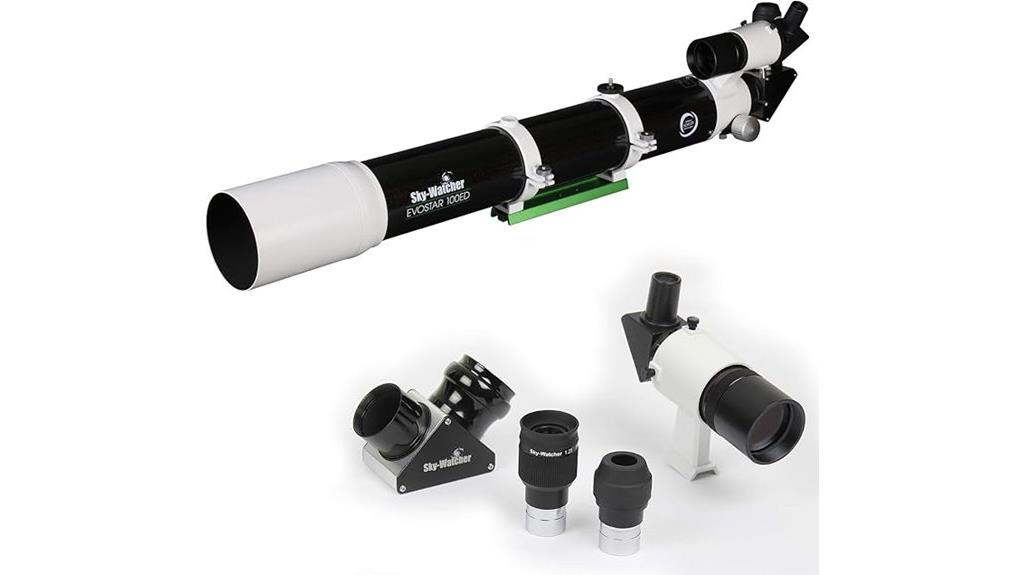
For amateur astronomers seeking a portable yet high-performing refractor, the Sky-Watcher EvoStar 100 APO stands out as an excellent choice. Its expertly matched glass, including a synthetic fluorite element, delivers superb color correction for both visual and astrophotography. The scope features proprietary MHTC coatings that minimize false color and aberrations, resulting in sharp, vibrant images. Its lightweight design (around 8.4 pounds) and simple setup make it ideal for quick observations, whether under light-polluted or dark skies. With a 100mm aperture, it offers bright, detailed views of planets, deep-sky objects, and nebulae, making it versatile and user-friendly for all levels.
Best For: amateur astronomers seeking a portable, high-quality refractor suitable for both visual observing and astrophotography at an entry-level or intermediate skill level.
Pros:
- Excellent color correction and sharp images thanks to expertly matched glass and synthetic fluorite element
- Lightweight and easy to set up, weighing only around 8.4 pounds for portable use
- Comes with a comprehensive set of accessories, including a high-quality focuser and finderscope for quick setup and versatile observing
Cons:
- Limited aperture size may not be ideal for very faint deep-sky objects compared to larger telescopes
- Less suitable for heavy astrophotography setups due to its lightweight mount compatibility
- Slightly higher cost compared to basic beginner refractors with similar aperture but fewer features
Omegon Apochromatic Refractor Pro APO AP 66/400 ED OTA
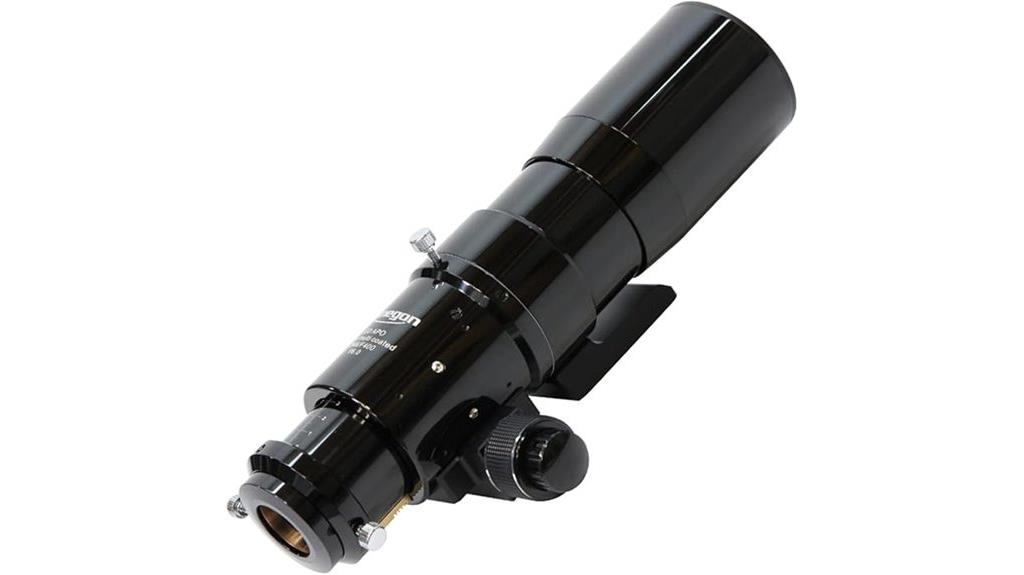
Designed for both amateur astronomers and outdoor enthusiasts, the Omegon Apochromatic Refractor Pro APO AP 66/400 ED OTA stands out with its compact, lightweight build, making it highly portable without sacrificing optical quality. Weighing just 9.46 pounds, it’s ideal for nature observation and astrophotography on the go. Its ED-APO double-lens objective minimizes color errors at high magnifications, delivering sharp, high-contrast images of lunar, planetary, and terrestrial subjects. The Power Linear focuser offers precise control, while compatibility with various accessories enhances versatility. Whether for detailed planetary views or wildlife photography, this refractor combines quality, portability, and ease of use.
Best For: outdoor enthusiasts, amateur astronomers, and nature photographers seeking a portable, high-quality refractor for terrestrial and celestial observations.
Pros:
- Compact and lightweight design for easy portability and travel.
- High-contrast, color-pure images thanks to ED-APO double-lens objective.
- Precise Power Linear focuser allows for fine adjustments ideal for astrophotography.
Cons:
- Limited aperture size may restrict detailed deep-sky observations.
- Customer ratings average around 4 out of 5 stars, indicating some users may experience minor optical or mechanical issues.
- Compatibility with accessories requires additional purchases, which could increase overall cost.
Refractor Fully Coated Glass Optics Adjustable Tripod
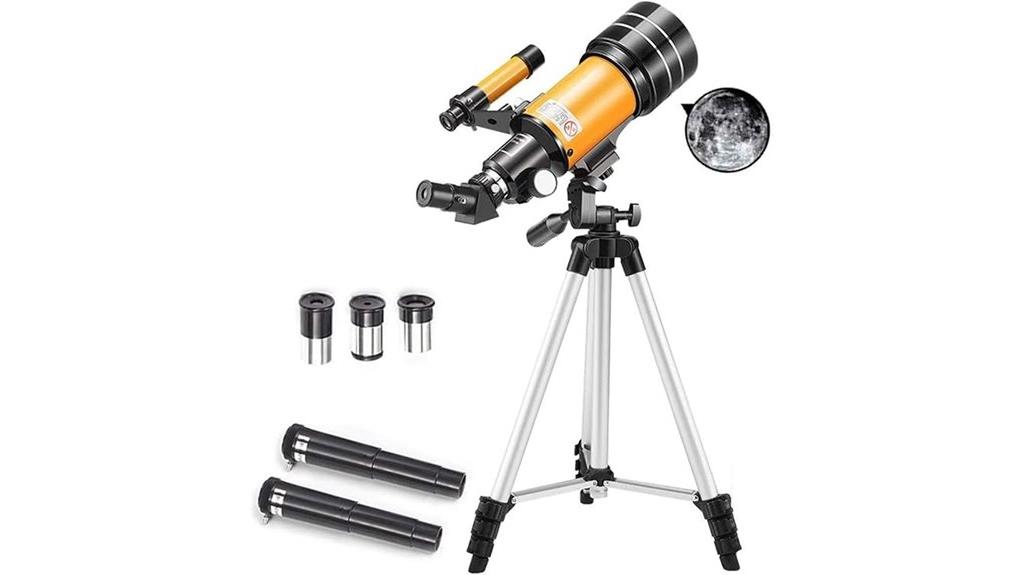
If you’re seeking a versatile and stable platform for your nebula observations, the Refractor Fully Coated Glass Optics Adjustable Tripod delivers. Its high-transmission, fully coated glass optics with a 400mm focal length and 70mm aperture boost image brightness and clarity while protecting your eyes. The full-size aluminum tripod is easy to assemble and offers stable, adjustable viewing positions, making setup simple even for beginners. It includes three replaceable eyepieces and two Barlow lenses, providing up to three times magnification. Perfect for moon, planets, and ground viewing, it encourages exploration and learning, making it a great choice for aspiring astronomers.
Best For: beginners, children, and space enthusiasts interested in exploring the night sky and learning about astronomy with an easy-to-use, stable telescope setup.
Pros:
- Fully coated, high-transmission glass optics for bright, clear images and eye protection.
- Adjustable full-size aluminum tripod ensures stable and versatile viewing positions.
- Includes multiple eyepieces and Barlow lenses for increased magnification and detailed observation.
Cons:
- Product dimensions are very small (0.39 inches), which may indicate a packaging or measurement error.
- May require additional accessories for advanced astrophotography or deep-sky observation.
- Assembly instructions might be simple, but some users could find initial setup challenging without prior experience.
SVBONY SV550 APO Telescope Bundle with Accessories
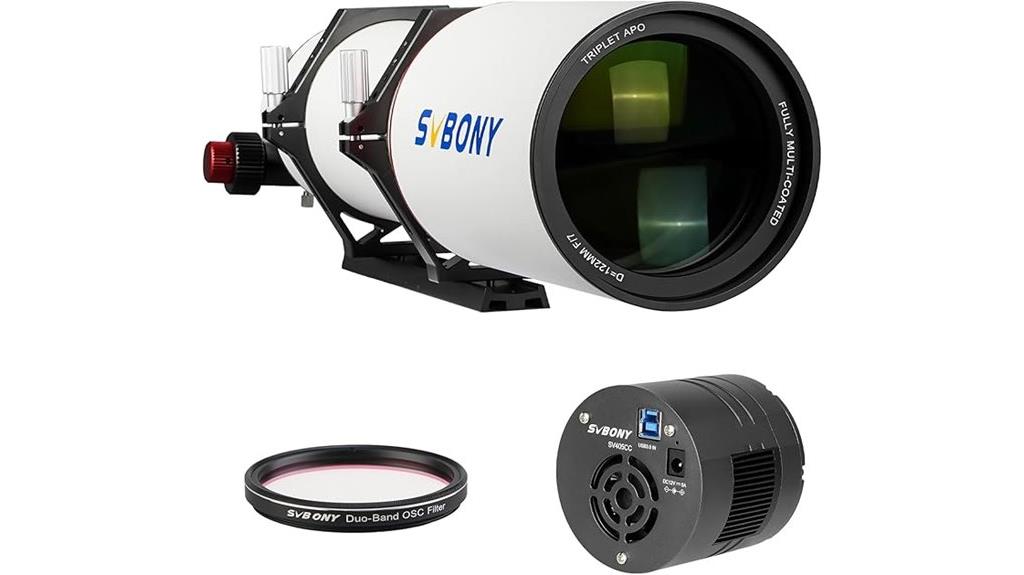
Are you looking for a portable yet powerful telescope to capture stunning nebulae? The SVBONY SV550 APO Telescope Bundle offers a 122mm aperture and f/7 focal ratio in a lightweight, travel-friendly design. Its triplet apochromatic lens with FPL-51 ED glass minimizes chromatic aberration, delivering crisp, clear images. The bundle includes the SV405CC cooled color camera, perfect for deep sky astrophotography, along with a 2-inch Dual-Band Nebula Filter that reduces light pollution and enhances nebula details. Weighing just over 6 kg, it’s easy to take on trips, making it ideal for astrophotographers wanting high-quality views of faint objects and nebulae.
Best For: astrophotographers and astronomy enthusiasts seeking a portable, high-quality telescope capable of capturing faint deep sky objects and nebulae.
Pros:
- Combines a 122mm aperture and apochromatic triplet lens for sharp, high-contrast images with minimal chromatic aberration.
- Includes a cooled color camera and dual-band nebula filter, enhancing deep sky imaging and reducing light pollution.
- Lightweight and travel-friendly design, weighing just over 6 kg, ideal for portable astrophotography and observation.
Cons:
- As a specialized astrophotography bundle, it may be more expensive than entry-level telescopes.
- Requires some knowledge of astrophotography setup and image processing for optimal results.
- The bundled accessories, while high quality, may need upgrades or additional equipment for advanced astrophotography.
Factors to Consider When Choosing An Apochromatic Refractor for Nebulae
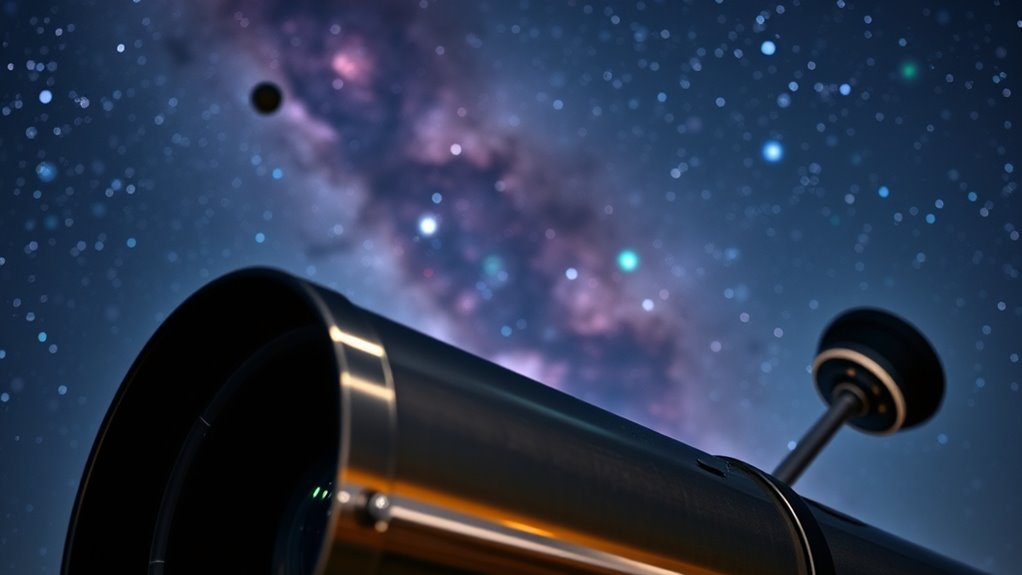
When selecting an apochromatic refractor for nebulae, I focus on key factors like aperture size and chromatic aberration control to get clear, detailed images. I also consider the quality of the optical glass and whether the focal length suits my observing needs. finally, I check if the mount is compatible, ensuring stability during long exposures.
Aperture Size Importance
Aperture size plays an essential role in selecting an apochromatic refractor for nebulae because it directly influences how much light the telescope can gather. A larger aperture allows more light to enter, making faint nebulae more visible and increasing image brightness. It also improves resolution, revealing finer detail within nebulae structures. For deep-sky astrophotography of dim objects, a bigger aperture is *vital* to gather sufficient light. However, larger apertures tend to be heavier and less portable, which can impact setup convenience. For effective nebulae observation, I recommend an aperture of at least 80mm. This size strikes a good balance between light-gathering power and portability, ensuring you can enjoy stunning views without sacrificing ease of use.
Chromatic Aberration Control
Controlling chromatic aberration is key to getting sharp, true-to-color images of nebulae through an apochromatic refractor. These telescopes use specialized lens elements, like FPL-51 ED glass, to reduce color fringing and produce clearer images. The air-spaced triplet design further minimizes chromatic aberration, delivering cleaner deep-sky views. Proper regulation of this aberration enhances color accuracy and reveals subtle details in faint nebulae, improving astrophotography outcomes. High-quality coatings and precise lens alignment are essential for reducing residual chromatic aberration and maximizing contrast. Additionally, the focal length and aperture size influence aberration control, with larger apertures requiring top-tier lens elements to maintain image clarity. By focusing on chromatic aberration control, you ensure vibrant, sharp, and true-to-color nebulae views.
Optical Glass Quality
The quality of optical glass in an apochromatic refractor plays a pivotal role in achieving sharp, true-to-color images of nebulae. High-grade glass like FPL-51 or FCD1 ED minimizes chromatic aberration, resulting in sharper images with accurate color rendition of faint deep-sky objects. Precise polishing and multilayer coatings on the glass enhance light transmittance and reduce internal reflections, boosting contrast and brightness. The purity and homogeneity of top-quality glass prevent distortions and aberrations that can obscure delicate nebula details. Opting for refractors with well-crafted, fully coated optics ensures minimal false color and maximized contrast. This level of glass quality is essential for both visual observation and astrophotography, allowing me to see and capture nebulae with stunning clarity and true-to-life colors.
Focal Length Suitability
Choosing the right focal length for an apochromatic refractor can considerably impact your nebula imaging results. Longer focal lengths, like 714mm or 854mm, deliver higher magnification and finer detail, making them perfect for deep-sky astrophotography of nebulae. They emphasize intricate features but have a narrower field of view. Conversely, shorter focal lengths around 400mm to 600mm provide wider views, ideal for capturing large nebulae and star clouds in a single shot. A focal length between 700mm and 1000mm often strikes a good balance, offering sufficient detail without sacrificing brightness or field coverage. Always consider your mount’s capabilities and camera setup, as compatibility is *vital* for stable tracking and achieving sharp, stunning images.
Mount Compatibility Needs
When selecting an apochromatic refractor for nebula imaging, guaranteeing mount compatibility is essential to achieve stable and precise results. First, check that the scope’s mounting interface, like a dovetail or specific foot, matches your existing mount or tripod. It’s also critical to verify that the scope’s weight and size fall within your mount’s load capacity to prevent instability. Make sure the mount offers accurate tracking and enough payload capacity to support both the refractor and your camera gear for long exposures. Additionally, confirm that it’s compatible with guiding accessories or guide scopes, which are indispensable for precise tracking during nebula imaging. Lastly, ensure your mount can support necessary accessories, such as counterweights and adapters, to secure the setup and maintain alignment throughout your imaging session.
Portability and Weight
Opting for a lightweight apochromatic refractor can make a significant difference in how easily you can transport and set up your telescope for nebulae imaging. Telescopes under 10 pounds are much easier to carry to remote sites, saving you time and effort. Shorter tube models are also more convenient for quick setups, which is essential for spontaneous imaging sessions. The weight of your telescope directly affects the stability of your mount, essential for capturing sharp, detailed images of faint nebulae. Carrying a lighter refractor reduces fatigue during long observing sessions, making the experience more enjoyable. Plus, compact, lightweight telescopes are perfect for travel, allowing you to explore nebulae in various locations without the hassle of heavy gear.
Accessories and Expandability
To get the most out of your apochromatic refractor for nebulae, paying attention to accessories and expandability options can really enhance your observing and imaging experience. Make certain your telescope is compatible with key accessories like diagonals, finderscopes, and mounting rings to broaden your observational capabilities. Check if it supports extension tubes or focal reducers, which are crucial for astrophotography and capturing detailed nebulae images. A variety of eyepiece sizes and focal lengths is essential for adjusting magnification to suit different objects. Additionally, verify the availability of filters, such as narrowband nebula filters, to improve contrast and detail. Finally, ensure your mount can accommodate guiding systems and camera adapters, simplifying long-exposure astrophotography sessions.
Budget and Cost Value
Choosing an apochromatic refractor for nebulae involves balancing your budget with the features that matter most. Prices range from around $300 for basic models to over $2000 for premium options, so your budget greatly influences your choices. Investing in a higher-cost scope usually means better optical quality, with improved contrast and color correction, which enhances nebula viewing. Budget-friendly models might have smaller apertures, simpler coatings, or basic focusing mechanisms, limiting their detail and brightness. When evaluating cost value, it’s essential to take into account the quality of the optical glass, aperture size, and included accessories, as these directly impact performance. Finding the right balance ensures you get the best possible nebulae views without overspending, making your investment worthwhile.
Frequently Asked Questions
How Do Apochromatic Refractors Compare to Other Telescope Types for Nebula Viewing?
Apochromatic refractors excel at nebula viewing because they offer sharp, high-contrast images with minimal chromatic aberration. Unlike reflector telescopes, which can have issues with image distortion and require more maintenance, apochromats provide clearer views with stunning detail. I find they’re fantastic for observing faint nebulae, making them my go-to choice when I want crisp, beautiful images without the hassle of complex collimation.
What Maintenance Is Required to Keep Apochromatic Refractors Optimal?
To keep my apochromatic refractor ideal, I regularly clean the lenses with a soft brush and lens cleaning solution, avoiding harsh chemicals. I also store it in a dry, dust-free environment and use a cover when not in use. Periodically, I check and tighten any loose screws or mounting components to guarantee stability. Proper maintenance helps me enjoy clear, stunning views of nebulae every time I observe.
Can These Telescopes Be Used Effectively for Astrophotography of Nebulae?
Absolutely, apochromatic refractors are excellent for astrophotography of nebulae. I’ve used mine to capture stunning images because their crisp, color-accurate views help reduce chromatic aberration. Just make certain you invest in a sturdy mount, use proper tracking, and select the right camera and filters. With patience and the right techniques, these telescopes can produce breathtaking astrophotos, making them a top choice for deep-sky imaging.
Are There Any Specific Accessories Recommended for Nebula Observation?
Think of accessories as your trusty sidekicks in the quest for stunning nebula views. I recommend a good UHC or OIII filter to cut through light pollution and reveal those faint details. A sturdy, motorized mount helps track objects smoothly, while a moon filter can improve contrast. Don’t forget a red flashlight for night vision and a dew shield to keep your lens clear—these little helpers make a big difference.
How Does Aperture Size Influence Nebulae Viewing Quality Through Apochromatic Refractors?
Aperture size directly impacts the quality of nebulae views through apochromatic refractors. Larger apertures gather more light, revealing finer details and making faint nebulae brighter and more vibrant. I’ve found that increasing aperture improves contrast and resolution markedly. However, bigger telescopes can be bulkier and more expensive, so I recommend balancing aperture size with your space and budget to get the best viewing experience for nebulae.
Conclusion
Choosing the right apochromatic refractor feels like finding a trusted companion for my stargazing adventures. With options that deliver stunning views of nebulae, you’re sure to find one that resonates with your passion. Remember, it’s not just about equipment, but the journey of discovery it sparks. Like a well-tuned symphony, the perfect telescope transforms distant clouds into breathtaking masterpieces—ready to ignite your curiosity and elevate your celestial explorations.
